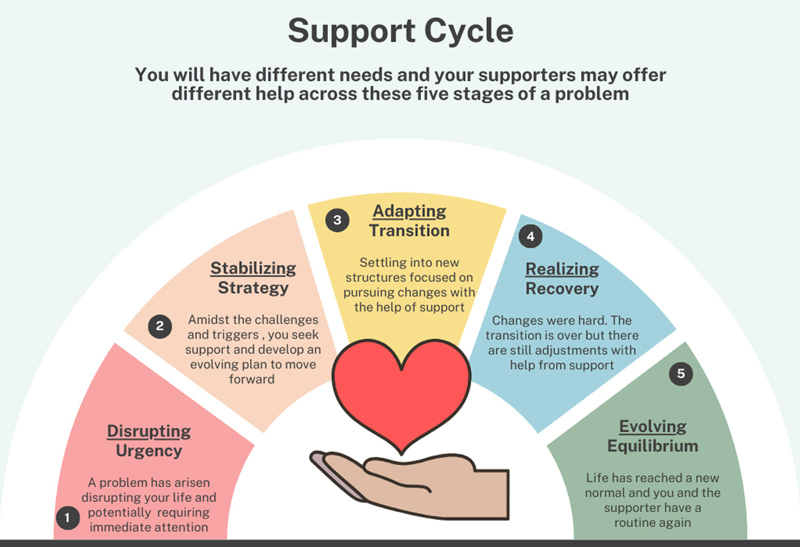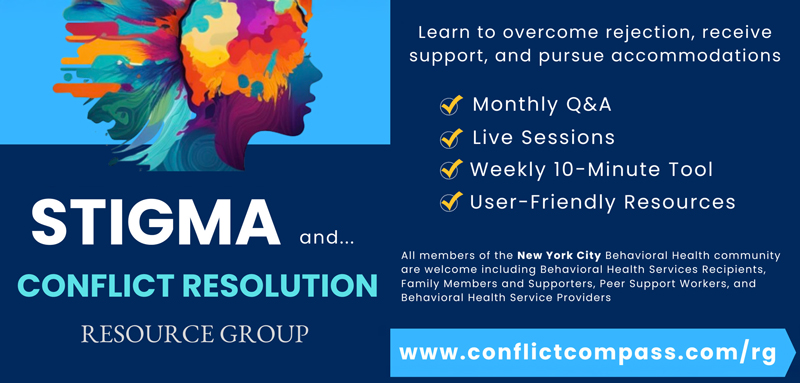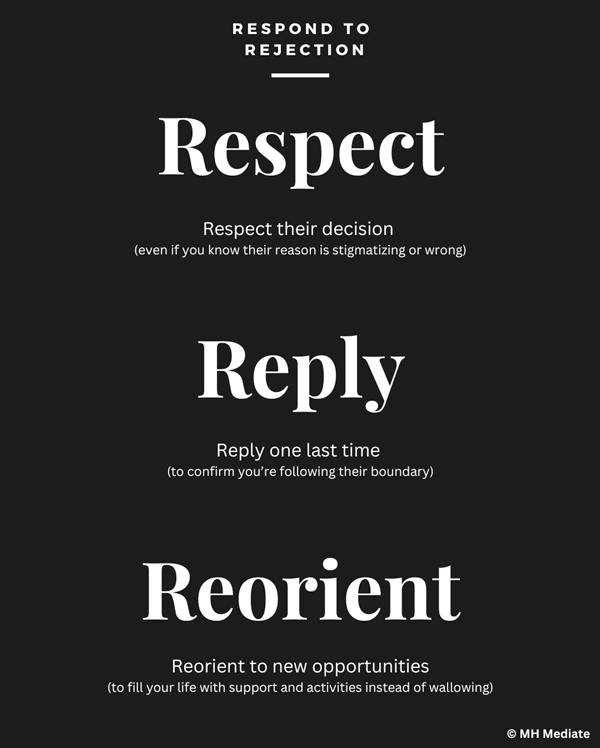Mental illness stigma might mean folks inappropriately assume someone living with a mental health condition is dangerous, incapable, or socially undesirable. When those negative attitudes translate into harmful actions, the results can be devastating. Stigma often leads to friends or family pulling away from offering support, coworkers or colleagues rejecting someone from social and professional opportunities, and organizations dismissing reasonable requests for needed disability accommodations to access schools, workplaces, or the community.

The “Nurturing Relationships” tipsheet includes the Support Cycle diagram, to help users understand that there are different times when someone who needs support has different needs and expectations from their supporters. It also includes a chart of “Your Needs and Your Supporter’s Needs” to help explore what everybody needs during each of these stages, in order to structure a mutually beneficial support relationship.
What Can Be Done to Address These Challenges?
The Stigma and Conflict Resolution Resource Group is a free resource hub being shared with the New York behavioral health community and beyond. It was produced by MH Mediate’s Mindquity platform, with support from the New York State Office of Mental Health via New York State’s Mental Illness Anti-Stigma Fund Tax Check-off Program and from the New York City Department of Health and Mental Hygiene’s Office of Consumer Affairs. The Resource Group is designed specifically to help users apply conflict resolution best practices when navigating challenges they face across three key situations: seeking support, overcoming rejection, and pursuing accommodations.
Tools for seeking support include:
- Appreciating Supporter Needs
- Deciding on an Outreach Strategy
- Asking with Gratitude
- Nurturing Relationships
- Adjusting to Changes
Resources for overcoming rejection include:
- Clarifying Whether Rejection Occurred
- Deciding Whether to Speak Up
- Seeking Support
- Reorienting After Rejection
- Addressing Stigma and Discrimination
Guides for pursuing accommodation include:
- Addressing Self-Stigma
- Deciding Disclosure
- Navigating Logistical Burdens
- Overcoming Communication Challenges
- Asking for Adjustments
All tools and videos from the Stigma and Conflict Resolution Resource Group are available for free at www.conflictcompass.com/rg. Organizations, communities, and support groups who would like assistance integrating these resources into their communities can contact MH Mediate for assistance at dan@mhmediate.com.

Anyone can join the Stigma and Conflict Resolution Resource Group to access the fifteen different tools and videos, and four skills sessions, by visiting www.conflictcompass.com/rg.
Below, we highlight six of the tools featured in the Resource Group and share how they support real-life situations involving stigma and conflict.
- Support: Appreciate Supporter Needs
This tool lays the foundation for seeking support by encouraging users to step back and consider the day-to-day realities facing the people they’re reaching out to – people who may be busy or going through problems of their own. It helps users map out possible supporters, their capacity, and their own hopes and fears about asking for help. Users are guided to appreciate their supporters’ own stressors, time limitations, and interpersonal dynamics. A structured worksheet prompts people to name potential supporters, assess how much they trust them, identify what kind of support they hope for, and consider the best timing to approach them. This tool promotes empathy and realism—and helps avoid disappointment or resentment.
- Support: Asking with Gratitude
Once a user identifies potential supporters, this tool helps them plan how to ask for help. It includes templates for outreach messages, planning guides, and reflection exercises. The emphasis is on making “asks” that are thoughtful and flexible, showing appreciation rather than entitlement. The worksheet walks users through each step: what stage of a problem they’re in, what kinds of help would be useful, who could offer it, and what level of investment is being asked. This approach reduces the emotional load for both the asker and the supporter, and increases the chance that the help will be sustainable. By being clear about what kind of support is being asked for, it can reduce the chance that the prospective supporter is overwhelmed.
- Rejection: Clarifying Whether Rejection Occurred
Many people who have experienced trauma or marginalization carry heightened sensitivity to rejection. This tool breaks down ambiguous interactions and helps users assess whether rejection has truly occurred or if something else might be happening. It starts by having the user list observable behaviors (e.g., not responding to messages, avoiding contact). Then it asks what assumptions are being made and whether alternative explanations exist. It concludes by guiding users toward grounded next steps. This can prevent spirals of shame or self-blame and promote clearer, calmer communication. It can also help develop clear evidence of stigmatizing rejection, if that is indeed what is happening.
- Rejection: Deciding Whether to Speak Up
Sometimes, rejection is real—and the next choice is whether or not to speak up in response. This tool supports thoughtful decision-making by offering a step-by-step process to evaluate how the user feels, what the context is, what the relationship dynamic is, and what the risks and benefits might be. The “Deciding Whether to Speak Up” worksheet provides a checklist of reasons someone might choose to speak up (e.g., seeking closure, restoring trust) and reasons they might hold back (e.g., needing emotional safety, waiting for clarity). It ends with options for how to frame the conversation if they decide to engage.

The “Reorienting After Rejection” tipsheet presents the 3R’s. These three steps are also described in a short video and during a one-hour rejection skills session, with a goal of empowering people to respect someone’s decision to reject them, reply just once, and then reorient to new opportunities rather than stay stuck pursuing the lost one.
- Accommodations: Deciding Disclosure
This tool focuses on what can be a very difficult, personal decision for someone living with an otherwise invisible mental-health-related life impairment: whether to disclose their diagnosis or disability limitation as part of seeking support or accommodations. The worksheet offers legal context, reflection questions, and a list of pros and cons for sharing more or less information. It also helps them understand what kinds of questions or exams may be inappropriate for people to ask for as part of the disclosure process. In considering the choice to share more information, the tool helps users identify their concerns (e.g., stigma, retaliation), emotional reactions (e.g., shame, fear, hope), and past experiences. It reinforces the user’s autonomy by making clear that disclosure is a personal choice—and that limited disclosure is often enough.
- Accommodations: Navigating Logistical Burdens
Even after accommodations are requested, people can face delays, denials, poor implementation, or even retaliation. This tool outlines common post-request obstacles and provides calm, strategic options for responding. The worksheet shares ideas of what to do if a request is ignored, ways to challenge policies respectfully, things to say when implementation is poor, and possible options for handling backlash from others.
Conclusion: A System for Surviving and Thriving Amidst Stigma
Together, these resources provide a system of support for people navigating stigma—not just by naming it, but by offering practical pathways to respond. The full collection of 15 tools, along with videos and skills sessions, is available for free at www.conflictcompass.com/rg.
Dan Berstein, MHS, is a mediator living with bipolar disorder, working to help all mental health stakeholders use conflict resolution best practices to prevent mental illness stigma and discrimination. Dan developed MH Mediate’s Mindquity platform to help people with mental health conditions use conflict resolution best practices to address day-to-day stigma challenges. Dan continues to help mental health stakeholders and organizations freely share access to these resources. E-mail dan@mhmediate.com if you would like to integrate them into your community.




